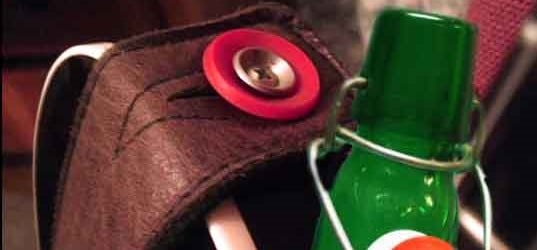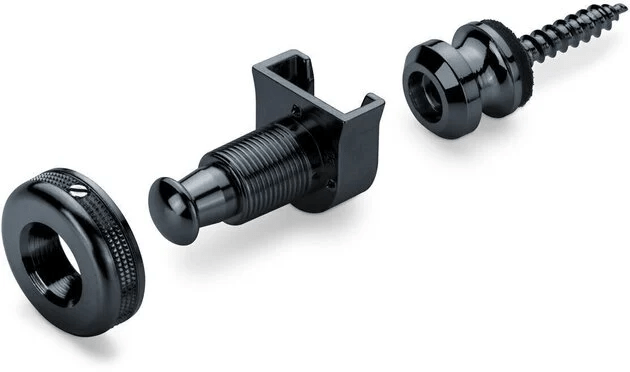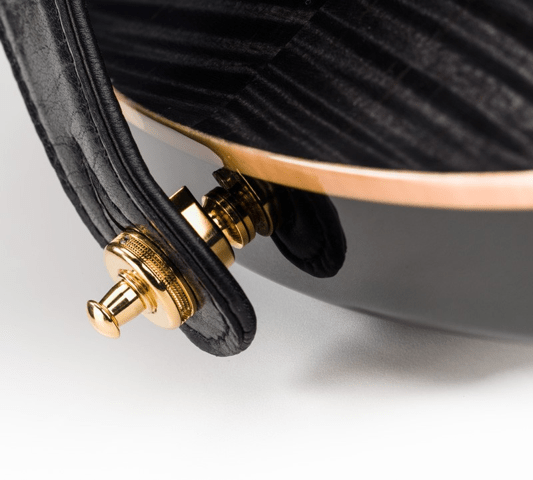Strap Pins
Yes! Even the humble strap pin is potentially upgradeable.
On the importance of strap pins
If you play standing, your strap pin is all that stands between a great performance and making a guitar-shaped dent in your floor. It’s much more important to both your comfort and your guitar’s safety than it might seem at first!
There are a number of reasons why one might consider replacing the strap pins on their guitar:
- Switching to a different color for aesthetic reasons (e.g. replacing a chrome strap pin with a black one)
- Switching to a different design for aesthetic reasons or to minimize strap slippage (e.g. switching from a V-shaped pin to a T-shaped one)
- Upgrading to strap locks to entirely remove the risk of the strap coming loose
- Relocating the strap pin to improve the balance of the instrument (e.g. moving it from the back of the body to the upper horn on some SG-style guitars)
Let’s talk about all the different kinds of strap pins.
A strap pin is very simple in construction — it’s a piece of (usually) metal, attached to the guitar body with a simple screw with a (usually felt) washer between the pin and the body to avoid damaging the finish. Strap pins come in all kinds of shapes and sizes — from the classic V-shape all the way to novelty designs like skulls and stars — and in all finishes and materials, from classic nickel to buffalo horn.
Strap Pins Of All Shapes And Sizes
Almost all guitars will come stock with the — frankly, subpar — V-shaped strap pins (pictured to the right).
Honestly, I hate this design. As you can clearly see, there is very little holding the strap in place, and heavier guitars or basses will readily come crashing to the floor if the strap slips.
Luckily, there are plenty of variations on this standard formula.
Fox’s Gear: Gotoh EP-B3 oversize strap pins
My personal favorite by far is Gotoh’s EP-B3 style of strap pin, once again visible on the right.
They’re significantly oversized compared to a classic V-shape pin and have a “T” rather than a “V” profile, making them much more resistant to strap slippage. I also think they look great; they look big and unique and, especially if your hardware contrasts with the color of your guitar’s finish, can stand out in a very positively striking way. Check them out on the FGN Iliad, below:
> The FGN Iliad JIL2ASHM, with oversize Gotoh EP-B3 strap pins.
Every hardware manufacturer and their mom have a bunch of minor variations on the basic strap pin. Gotoh, for instance, other than the oversized-T EP-B3 mentioned above, also make a standard V-shape EP-B2 and a standard-size T-shape EP-B1.
D’Addario makes strap pins with an elliptical profile, which seems like a great solution for strap retention, but I happen to dislike the way they look. Pictured on the right:
There are innumerable variations on these few designs, but there are also two other significant categories of strap pins: novelty designs and strap locks.
Let’s talk about novelty strap pins.
Since a strap pin is just a piece of metal with a screw, it turns out that anything you can attach a screw to can be a strap pin with the right attitude!
Grover is the only “big” hardware manufacturer I know of to make novelty strap pins. They have a small selection of designs, including classics like skulls or stars.
For anything else, you’ll probably have to look to Etsy, Reverb, Amazon, or Ebay. Strap pins are the one piece of hardware where I would even suggest looking to Aliexpress, but I couldn’t find any novelty pins on there. I did find some nice ones on Ebay, though.
Now that we’ve looked at all the different kinds of “standard” strap pins, let’s talk about strap locks.
Strap Blocks, Strap Locks
What’s a strap lock, anyway?
A “strap lock” is any solution that goes over your strap once you’ve secured it onto the strap pin and locks it in place.
If the strap pin is not sufficient for keeping your strap secure — and, let’s face it, it almost never is — it’s time to look for straplocks.
Depending on the design, the chance of your strap coming loose if you have a straplock on ranges from “basically impossible” to “mechanically impossible”.
Let’s start with my favorite, the zero-cost solution that requires no modification to the guitar, does not make the strap pin any more bulky, and can serve as a nice colorful accent: the “Blues Straplock”.
If you’re of drinking age, Grolsch beer comes in a fancy flip top bottle with a rubber seal on the cap. With a bit of effort, you can get the seal off the cap, pull it over the top of your strap and pin, and have a very secure and near-zero-cost solution that will keep the strap in place:
 The “Blues
Straplock”.
The “Blues
Straplock”.
If you’re not of drinking age, the rubber seals can be ordered in bulk from Amazon or any homebrewing supplier for dirt cheap; google for “Grolsch gaskets pack”. These are such a classic that a couple guitar companies even sell branded versions in a variety of colors for a couple bucks (the Fender ones pictured on the right)!
“Proper” strap locks, on the other hand, are something quite significantly different, but they all broadly follow the same idea — rather than having a one-piece pin that your strap is pulled over the top of, and held in place with gravity, friction, and prayers, a strap lock adds a second mechanical part that is then secured over the top of the strap, preventing it from coming loose.
The industry standard (to the point that some manufacturers, like Ibanez, are now including them as a standard feature on some of their guitars!), and the example I will use to explain how a strap lock works, is Schaller’s S-Lock system:
 The Schaller S-Lock System.
The Schaller S-Lock System.
With Schaller S-Locks, you “clamp” the strap between the lock wheel (the round part with a threaded hole) and the lock body (the long threaded part); when you want to attach the strap to the guitar, you pull on the pin at the end of the lock body (which retracts an internal bolt that locks into the hole at the end of the strap button itself) and slide the whole assembly over the strap button.
Conversely, to detach the strap, you pull on the pin and slide the lock+strap+wheel assembly off the strap button.
This arrangement makes it mechanically impossible for the strap to come loose unless you pull on the lock pin.
 A strap attached to a guitar with
a Schaller S-Lock.
A strap attached to a guitar with
a Schaller S-Lock.
Virtually all other strap locks work on the same principle — the exact locking and unlocking method may differ, but they’re all some form of mechanism that slides over the strap button and locks in place.
Although they’re all kinda the same, there are two strap locks that I’d like to give a special shoutout to:
- Fender Infinity Strap Locks, because they come in a pretty sick metallic red:
- Dunlop Flush Mount Straploks, because they’re unique in that they don’t stick out massively from your guitar. On the other hand, this is because they mount into the body, and thus require you to drill a big hole into your guitar:
On that last note, I don’t like strap locks precisely because almost all the designs out there stick out a mile and look extremely gamer, and some of the pointier designs (Schaller) make it actively painful to play in a classical position because they will stab your thigh. Having said that, that’s just my personal take, and by all means, if you struggle with strap retention or want your guitar to be as gamer as possible — look into strap locks.